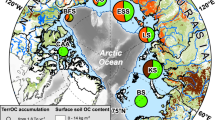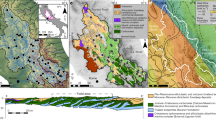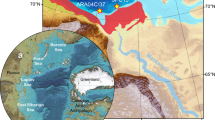Abstract
The erosion and weathering of mountain ranges exert a key control on the long-term (105–106 yr) cycling of carbon between Earth’s surface and crust. The net carbon budget of a mountain range reflects the co-existence of multiple carbon sources and sinks, with corresponding fluxes remaining difficult to quantify. Uncertain responses of these carbon fluxes due to the stochastic nature of erosional processes further complicate the extrapolation of short-term observations to longer, climatically relevant timescales. Here, we quantify the evolution of the organic and inorganic carbon fluxes in response to the 2015 Gorkha earthquake (Mw 7.8) in the central Himalaya. We find that the Himalayan erosion acts as a net carbon sink due mainly to efficient biospheric organic carbon export. Our high-resolution time series encompassing four monsoon seasons before and after the Gorkha earthquake reveal that coseismic landslides did not significantly perturb large-scale Himalayan sediment and carbon fluxes. This muted response of the central Himalaya to a geologically frequent perturbation such as the Gorkha earthquake further suggests that our estimates are representative of at least interglacial timescales.
This is a preview of subscription content, access via your institution
Access options
Access Nature and 54 other Nature Portfolio journals
Get Nature+, our best-value online-access subscription
$29.99 / 30 days
cancel any time
Subscribe to this journal
Receive 12 print issues and online access
$259.00 per year
only $21.58 per issue
Buy this article
- Purchase on Springer Link
- Instant access to full article PDF
Prices may be subject to local taxes which are calculated during checkout




Similar content being viewed by others
Data availability
All data analysed in this study are available in the Research Collection of ETH Zurich at http://hdl.handle.net/20.500.11850/487683. Source data are provided with this paper.
Change history
22 December 2021
A Correction to this paper has been published: https://doi.org/10.1038/s41561-021-00882-2
References
Berner, R. A. & Canfield, D. E. A new model for atmospheric oxygen over Phanerozoic time. Am. J. Sci. 289, 333–361 (1989).
Walker, J. C. G., Hays, P. B. & Kasting, J. F. A negative feedback mechanism for the long-term stabilization of Earth’s surface temperature. J. Geophys. Res. Ocean. 86, 9776–9782 (1981).
West, A. J. Thickness of the chemical weathering zone and implications for erosional and climatic drivers of weathering and for carbon-cycle feedbacks. Geology 40, 811–814 (2012).
Galy, V., Peucker-Ehrenbrink, B. & Eglinton, T. Global carbon export from the terrestrial biosphere controlled by erosion. Nature 521, 204–207 (2015).
Hilton, R. G. & West, A. J. Mountains, erosion and the carbon cycle. Nat. Rev. Earth Environ. 1, 284–299 (2020).
Raymo, M. E. & Ruddiman, W. F. Tectonic forcing of late Cenozoic climate. Nature 357, 57–59 (1992).
France-Lanord, C. & Derry, L. A. Organic carbon burial forcing of the carbon cycle from Himalayan erosion. Nature 390, 65–67 (1997).
Galy, V., France-Lanord, C. & Lartiges, B. Loading and fate of particulate organic carbon from the Himalaya to the Ganga–Brahmaputra delta. Geochim. Cosmochim. Acta 72, 1767–1787 (2008).
Evans, M. J., Derry, L. A. & France-Lanord, C. Degassing of metamorphic carbon dioxide from the Nepal Himalaya. Geochem. Geophys. Geosyst. 9, Q04021 (2008).
Hilton, R. G., Gaillardet, J., Calmels, D. & Birck, J. L. Geological respiration of a mountain belt revealed by the trace element rhenium. Earth Planet. Sci. Lett. 403, 27–36 (2014).
Calmels, D., Gaillardet, J., Brenot, A. & France-Lanord, C. Sustained sulfide oxidation by physical erosion processes in the Mackenzie River basin: climatic perspectives. Geology 35, 1003–1006 (2007).
Galy, A. & France-Lanord, C. Weathering processes in the Ganges–Brahmaputra basin and the riverine alkalinity budget. Chem. Geol. 159, 31–60 (1999).
Bickle, M. J. et al. Chemical weathering outputs from the flood plain of the Ganga. Geochim. Cosmochim. Acta 225, 146–175 (2018).
Kemeny, P. C. et al. Sulfate sulfur isotopes and major ion chemistry reveal that pyrite oxidation counteracts CO2 drawdown from silicate weathering in the Langtang–Trisuli–Narayani River system, Nepal Himalaya. Geochim. Cosmochim. Acta 294, 43–69 (2021).
Horan, K. et al. Carbon dioxide emissions by rock organic carbon oxidation and the net geochemical carbon budget of the Mackenzie River basin. Am. J. Sci. 319, 473–499 (2019).
Hilton, R. G. et al. Tropical-cyclone-driven erosion of the terrestrial biosphere from mountains. Nat. Geosci. 1, 759–762 (2008).
Wang, J. et al. Long-term patterns of hillslope erosion by earthquake-induced landslides shape mountain landscapes. Sci. Adv. https://doi.org/10.1126/sciadv.aaz6446 (2020).
Wang, J. et al. Earthquake-triggered increase in biospheric carbon export from a mountain belt. Geology https://doi.org/10.1130/G37533.1 (2016).
Frith, N. V. et al. Carbon export from mountain forests enhanced by earthquake-triggered landslides over millennia. Nat. Geosci. 11, 772–776 (2018).
Emberson, R., Hovius, N., Galy, A. & Marc, O. Chemical weathering in active mountain belts controlled by stochastic bedrock landsliding. Nat. Geosci. 9, 42–45 (2016).
Emberson, R., Galy, A. & Hovius, N. Weathering of reactive mineral phases in landslides acts as a source of carbon dioxide in mountain belts. J. Geophys. Res. Earth Surf. 123, 2695–2713 (2018).
Avouac, J. P., Bollinger, L., Lave, J., Cattin, R. & Flouzat, M. Seismic cycle in the Himalayas. C. R. Acad. Sci. IIa 333, 513–529 (2001).
Avouac, J.-P., Meng, L., Wei, S., Wang, T. & Ampuero, J.-P. Lower edge of locked Main Himalayan Thrust unzipped by the 2015 Gorkha earthquake. Nat. Geosci. 8, 708–711 (2015).
Roback, K. et al. The size, distribution, and mobility of landslides caused by the 2015 Mw 7.8 Gorkha earthquake, Nepal. Geomorphology 301, 121–138 (2018).
Andermann, C. et al. Impact of transient groundwater storage on the discharge of Himalayan rivers. Nat. Geosci. 5, 127–132 (2012).
Andermann, C., Crave, A., Gloaguen, R. & Davy, P. Connecting source and transport: suspended sediments in the Nepal Himalayas. Earth Planet. Sci. Lett. 352, 158–170 (2012).
Morin, G. P. et al. Annual sediment transport dynamics in the Narayani basin, central Nepal: assessing the impacts of erosion processes in the annual sediment budget. J. Geophys. Res. Earth Surf. 123, 2341–2376 (2018).
Hydrological Data and Suspended Sediment Concentration Records (Department of Hydrology and Meteorology of Nepal, 2019).
Marc, O., Hovius, N., Meunier, P., Uchida, T. & Hayashi, S. Transient changes of landslide rates after earthquakes. Geology 43, 883–886 (2015).
Menges, J. et al. Variations in organic carbon sourcing along a trans-Himalayan river determined by a Bayesian mixing approach. Geochim. Cosmochim. Acta 286, 159–176 (2020).
Dalai, T. K., Singh, S. K., Trivedi, J. R. & Krishnaswami, S. Dissolved rhenium in the Yamuna River System and the Ganga in the Himalaya: role of black shale weathering on the budgets of Re, Os, and U in rivers and CO2 in the atmosphere. Geochim. Cosmochim. Acta 66, 29–43 (2002).
Rahaman, W., Singh, S. K. & Shukla, A. D. Rhenium in Indian rivers: sources, fluxes, and contribution to oceanic budget. Geochem. Geophys. Geosyst. 13, Q08019 (2012).
Paul, M. Etude des Isotopes de l’Osmium dans les Eaux Souterraines du Bangladesh et les Sédiments Himalayens: Implications et Rôle de l’Erosion Himalayenne sur le Budget Océanique de l’Osmium. PhD Thesis, Université de Lorraine (2018).
Pierson-Wickmann, A. C., Reisberg, L. & France-Lanord, C. The Os isotopic composition of Himalayan river bedloads and bedrocks: importance of black shales. Earth Planet. Sci. Lett. 176, 203–218 (2000).
France-Lanord, C., Evans, M., Hurtrez, J. E. & Riotte, J. Annual dissolved fluxes from central Nepal rivers: budget of chemical erosion in the Himalayas. C. R. Geosci. 335, 1131–1140 (2003).
Bhatt, M. P., Hartmann, J. & Acevedo, M. F. Seasonal variations of biogeochemical matter export along the Langtang–Narayani river system in central Himalaya. Geochim. Cosmochim. Acta 238, 208–234 (2018).
Marc, O., Hovius, N., Meunier, P., Gorum, T. & Uchida, T. A seismologically consistent expression for the total area and volume of earthquake-triggered landsliding. J. Geophys. Res. Earth Surf. https://doi.org/10.1002/2015JF003732 (2016).
Wang, J. et al. Controls on fluvial evacuation of sediment from earthquake-triggered landslides. Geology 43, 115–118 (2015).
Howarth, J. D., Fitzsimons, S. J., Norris, R. J. & Jacobsen, G. E. Lake sediments record cycles of sediment flux driven by large earthquakes on the Alpine fault, New Zealand. Geology 40, 1091–1094 (2012).
Marc, O. et al. Long-term erosion of the Nepal Himalayas by bedrock landsliding: the role of monsoons, earthquakes and giant landslides. Earth Surf. Dyn. 7, 107–128 (2019).
Xu, C. et al. Two comparable earthquakes produced greatly different coseismic landslides: the 2015 Gorkha, Nepal and 2008 Wenchuan, China events. J. Earth Sci. 27, 1008–1015 (2016).
Stevens, V. L. & Avouac, J. P. Millenary Mw > 9.0 earthquakes required by geodetic strain in the Himalaya. Geophys. Res. Lett. 43, 1118–1123 (2016).
Galy, V. et al. Efficient organic carbon burial in the Bengal fan sustained by the Himalayan erosional system. Nature 470, 407–411 (2007).
Hemingway, J. D. et al. Microbial oxidation of lithospheric organic carbon in rapidly eroding tropical mountain soils. Science 360, 209–212 (2018).
Lupker, M. et al. Predominant floodplain over mountain weathering of Himalayan sediments (Ganga basin). Geochim. Cosmochim. Acta 84, 410–432 (2012).
Torres, M. A. et al. The acid and alkalinity budgets of weathering in the Andes–Amazon system: insights into the erosional control of global biogeochemical cycles. Earth Planet. Sci. Lett. 450, 381–391 (2016).
Garzanti, E. et al. Mineralogical and chemical variability of fluvial sediments 2. Suspended-load silt (Ganga–Brahmaputra, Bangladesh). Earth Planet. Sci. Lett. 302, 107–120 (2011).
Galy, V., Beyssac, O., France-Lanord, C. & Eglinton, T. Recycling of graphite during Himalayan erosion: a geological stabilization of carbon in the crust. Science 322, 943–945 (2008).
Lupker, M., France-Lanord, C., Galy, V., Lavé, J. & Kudrass, H. Increasing chemical weathering in the Himalayan system since the Last Glacial Maximum. Earth Planet. Sci. Lett. 365, 243–252 (2013).
Hein, C. J. et al. Post-glacial climate forcing of surface processes in the Ganges–Brahmaputra river basin and implications for carbon sequestration. Earth Planet. Sci. Lett. 478, 89–101 (2017).
Lenard, S. J. P. et al. Steady erosion rates in the Himalayas through late Cenozoic climatic changes. Nat. Geosci. 13, 448–452 (2020).
Lehner, B., Verdin, K. & Jarvis, A. New global hydrography derived from spaceborne elevation data. Eos 89, 93–104 (2008).
Larsen, I. J., Montgomery, D. R. & Korup, O. Landslide erosion controlled by hillslope material. Nat. Geosci. 3, 247–251 (2010).
Märki, L. et al. Molecular tracing of riverine soil organic matter from the central Himalaya. Geophys. Res. Lett. https://doi.org/10.1029/2020GL087403 (2020).
Eckhardt, K. How to construct recursive digital filters for baseflow separation. Hydrol. Process. 19, 507–515 (2005).
McIntyre, C. P. et al. Online 13C and 14C gas measurements by EA-IRMS–AMS at ETH Zürich. Radiocarbon 59, 893–903 (2017).
Wolff-Boenisch, D., Gabet, E. J., Burbank, D. W., Langner, H. & Putkonen, J. Spatial variations in chemical weathering and CO2 consumption in Nepalese High Himalayan catchments during the monsoon season. Geochim. Cosmochim. Acta 73, 3148–3170 (2009).
Tipper, E. T. et al. The short term climatic sensitivity of carbonate and silicate weathering fluxes: insight from seasonal variations in river chemistry. Geochim. Cosmochim. Acta 70, 2737–2754 (2006).
Burke, A. et al. Sulfur isotopes in rivers: insights into global weathering budgets, pyrite oxidation, and the modern sulfur cycle. Earth Planet. Sci. Lett. 496, 168–177 (2018).
Lupker, M., France-Lanord, C. & Lartiges, B. Impact of sediment–seawater cation exchange on Himalayan chemical weathering fluxes. Earth Surf. Dyn. 4, 675–684 (2016).
Horan, K. et al. Mountain glaciation drives rapid oxidation of rock-bound organic carbon. Sci. Adv. https://doi.org/10.1126/sciadv.1701107 (2017).
Miller, C. A., Peucker-Ehrenbrink, B., Walker, B. D. & Marcantonio, F. Re-assessing the surface cycling of molybdenum and rhenium. Geochim. Cosmochim. Acta 75, 7146–7179 (2011).
Pierson-Wickmann, A. C., Reisberg, L. & France-Lanord, C. Behavior of Re and Os during low-temperature alteration: results from Himalayan soils and altered black shales. Geochim. Cosmochim. Acta 66, 1539–1548 (2002).
Acknowledgements
L.M., M.L. and T.E. were supported by the Swiss National Science Foundation (no. 200021_166067). C. F.-L. and J.L. were supported by the ANR Calimero. We thank K. B. Adhikari from the hydrological station in Narayanghat for the daily sampling. E. Tipper (University of Cambridge) is thanked for kindly providing the confluence samples.
Author information
Authors and Affiliations
Contributions
L.M. and M.L. designed the study. M.L., C.F.-L., J.L., A.P.G. and S.G. organized and maintained daily sampling in Narayanghat. J.L. provided the depth profile samples, and L.M., M.L., C.F.-L., J.L. and S.G. conducted the soil sampling. L.M., N.H. and F.L.-W. prepared the samples and preformed the measurements. S.G. conducted the landslide volume calculation. L.M., M.L. and T.E. made the carbon flux calculations. All authors contributed to the interpretation of the data and the redaction of the manuscript.
Corresponding author
Ethics declarations
Competing interests
The authors declare no competing interests.
Additional information
Peer review information Nature Geoscience thanks Jin Wang, Kathryn Clark and the other, anonymous, reviewer(s) for their contribution to the peer review of this work. Primary Handling Editor: James Super.
Publisher’s note Springer Nature remains neutral with regard to jurisdictional claims in published maps and institutional affiliations.
Extended data
Extended Data Fig. 1 Measured discharge, calculated direct discharge and cumulative sediment flux of the Narayani River for the monsoon seasons 2015-2017.
Daily discharge (dark blue; ref. 28) and calculated direct discharge (light blue; calculated with a digital filter55 as described in ref. 27) for the months April – October of the years 2015, 2016 and 2017. The cumulative sediment flux is shown in grey and was only measured for the monsoon season (June-September).
Extended Data Fig. 2 Daily sediment load of the Narayani as a function of the total and direct discharge.
Daily sediment load data of the four studied years during the monsoon months plotted in log-log space against (a) the total river discharge (data from ref. 28) and (b) the direct river discharge (calculated with a digital filter55 as described in ref. 27) of the Narayani River at the sampling station in Narayanghat. The black line shows the linear correlation between the direct discharge and the sediment load with the one-sigma confidence intervals.
Extended Data Fig. 3 Mixing model used to disentangle the concentrations of petrogenic and biospheric organic carbon in suspended sediments.
TOC-1 plotted against the fraction modern of the bulk suspended sediment colored as a function of the sampling year. The biospheric and petrogenic endmembers used in the mixing model for disentangling OCbio and OCpetro inputs are schematically shown.
Extended Data Fig. 4 Biospheric organic carbon export in the water column of the Narayani River.
Extended Data Fig. 5 TOC concentration and fraction modern in sediments of rivers close to the sampling station.
(a) TOC concentration and (b) fraction modern in suspended sediments of the two tributaries shortly upstream the confluence and of two stations in the Narayani river colored as a function of the sampling date.
Extended Data Fig. 6 Cl− and SO4 2-concentrations as a function of the river discharge in Narayanghat.
(a) Cl− and (b) SO42− concentrations plotted against the discharge in log-log space. The anion concentrations of the samples 2015-2017 were measured and corrected for atmospheric input. Exponential functions (blacklines with the one-sigma confidence interval shown by the dashed lines) through the measured values were used to determine the concentrations of the 2010 samples with the river discharge (Q): [Cl] = e9.57 * Q-0.79 (r2=0.73); [SO4] = e7.45 * Q-0.3 (r2=0.51). For Cl, the 2017 concentrations were not taken into account (see Supplementary Information).
Extended Data Fig. 7 Cl versus Na concentrations of the measured monsoon seasons in Narayanghat.
Cl and Na concentrations are corrected for atmospheric input.
Extended Data Fig. 8 Sum of cations as a function of the Re concentration of global and Himalayan rivers.
Literature data are from refs. 10,15,31,32,61,62 and are illustrated by the diamonds. Dashed lines show linear regression between the measured sum of cations and Re concentrations of all the rivers (black) and of the Himalayan rivers (blue). Circles display the measured mean sum of cations in the Narayani per monsoon season as a function of the estimated Re concentration using the linear correlation of Himalayan rivers.
Supplementary information
Supplementary Information
Supplementary Information.
Source data
Source Data Fig. 2
Discharge and sediment load data of the Narayani River.
Source Data Fig. 3
Fraction modern and TOC concentration measured on suspended sediments, major ions concentrations measured on filtered water samples and calculated chemical weathering and OC export fluxes.
Source Data Fig. 4
Total calculated carbon fluxes associated with erosion in the Narayani catchment.
Source Data Extended Data Fig. 4
Fraction modern and TOC concentrations of suspended sediment samples within the water column of the Narayani.
Source Data Extended Data Fig. 5
Suspended sediment samples from rivers close to the sampling station in Narayanghat.
Rights and permissions
About this article
Cite this article
Märki, L., Lupker, M., France-Lanord, C. et al. An unshakable carbon budget for the Himalaya. Nat. Geosci. 14, 745–750 (2021). https://doi.org/10.1038/s41561-021-00815-z
Received:
Accepted:
Published:
Issue Date:
DOI: https://doi.org/10.1038/s41561-021-00815-z



